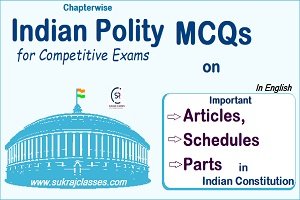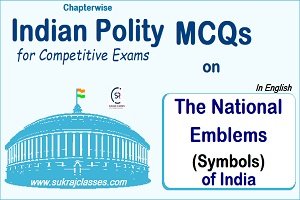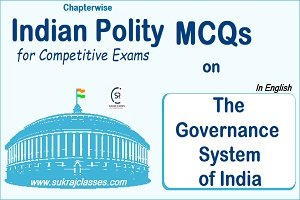
Indian Polity MCQs on The Constitutional Development of India
Que- 21. One amongst the following was not a salient feature of the Government of India Act, 1935.
(A) The Act provided for an All India Federation.
(B) Residuary subjects were allocated to provincial Legislatures.
(C) It marked the beginning of the Provincial Autonomy.
(D) It abolished Diarchy at the Provincial level and introduced it at the Centre.
Que- 22. Which one of the following is not an important and permanent constituent in the Constitutional History of India as adopted in the Government of India Act, 1935?
(A) A written Constitution for the country
(B) Elected representation responsible to the Legislature
(C) Envisaging a scheme of Federation
(D) Nomination of official members to the Legislature
Que- 23. Which one of the following Acts led to the separation of Burma from India?
(A) The Indian Councils Act, 1909
(B) Government of India Act, 1919
(C) Government of India Act, 1935
(D) Indian Independence Act, 1947
Que- 24. Why is the Government of India Act, 1935 important?
(A) It is the main source of the Constitution of India
(B) It gave Independence to India
(C) It envisages partition of India
(D) It abolished the Native States
Que- 25. The objective of Ilbert Bill in reference to colonial rule in India was __?
(A) To bring Indians and Europeans at equal status as far as the penal jurisdiction of courts was concerned.
(B) To put a strict restriction on local press because they were considered anti to colonial rulers.
(C) To conduct Administrative Service Exams in India to encourage Indians to participate in it.
(D) To amend the Arms Act for weapon permit to Indians.
Que- 26. The proposal for framing of the Constitution of India by an elected Constituent Assembly was made by __?
(A) Simon Commission
(B) Government of India Act, 1935
(C) Cripps Mission
(D) British Cabinet Delegation
Que- 27. Who among the following persons was not a member of the Cabinet Mission?
(A) William Wood
(B) Pethick Lawrence
(C) Stafford Cripps
(D) A.B. Alexander
Que- 28. As per Cabinet Mission plan, in the constituent assembly to decide allotted members’ seat in each province, one representative was in ratio to which population?
(A) 8 lakh
(B) 10 lakh
(C) 12 lakh
(D) 15 lakh
Que- 29. In the Interim Government formed in 1946, the Vice-President of the Executive Council was __?
(A) Jawaharlal Nehru
(B) Dr. S. Radhakrishnan
(C) C. Rajagopalachari
(D) Dr. Rajendra Prasad
Que- 30. Indian Constituent Assembly was established under __?
(A) Government of India Act, 1935
(B) Cripps Mission, 1942
(C) Cabinet Mission, 1946
(D) Indian Independence Act, 1947
Que- 31. Who gave the idea of a Constituent Assembly firstly for the formation of Constitution for India?
(A) Swaraj Party in 1934
(B) Congress Party in 1936
(C) Muslim League in 1942
(D) All Parties conference in 1946
Que- 32. Who of the following was not the member of the Interim National Government formed in August 1946 A.D.?
(A) C. Rajagopalachari
(B) Dr. Rajendra Prasad
(C) Dr. S. Radhakrishnan
(D) Jagjiwan Ram
Que- 33. Which one among the following is an incorrect statement about the Constituent Assembly?
(A) It worked with the help of a large number of committees, the most important among them being the Drafting Committee.
(B) Minority communities like Christians, Anglo-Indians and Parsis were adequately represented in the Assembly.
(C) It was elected on the basis of universal adult franchise.
(D) Its electoral process was based on the sixth schedule of the Act of 1935 which allowed for a restricted franchise based on tax, property and educational qualification.
Que- 34. How were the members of Constituent Assembly elected?
(A) Directly by public
(B) Nominated by Congress
(C) Nominated by Indian ruler
(D) By Provincial assemblies
Que- 35. With reference to Indian History, the Members of the Constituent Assembly from the Provinces were __?
(A) Directly elected by the people of those Provinces
(B) Nominated by the Indian National Congress and the Muslim League
(C) Elected by the Provincial Legislative Assemblies
(D) Selected by the government for their expertise in constitutional matters
Que- 36. Who chaired the first meeting of Constituent Assembly?
(A) Dr. Rajendra Prasad
(B) Dr. Bhimrao Ambedkar
(C) Dr. Sachchidanand Sinha
(D) Maulana Abul Kalam Azad
Que- 37. Who was the first elected Chairman of Constituent Assembly?
(A) Dr. B.R. Ambedkar
(B) Dr. Sachchidanand Sinha
(C) Dr. Rajendra Prasad
(D) Dr. S. Radhakrishnan
Que- 38. Constituent Assembly of India was established on __?
(A) 10 June, 1946
(B) 9 December, 1946
(C) 26 November, 1949
(D) 26 December, 1949
Que- 39. Who was the President of the Constituent Assembly of Independent India?
(A) Dr. Bhimrao Ambedkar
(B) Dr. Rajendra Prasad
(C) C. Rajagopalachari
(D) K. M. Munshi
Que- 40. Who proposed the Preamble before the Drafting Committee of the Constitution?
(A) Jawaharlal Nehru
(B) B.R. Ambedkar
(C) B.N. Rao
(D) Mahatma Gandhi





